Curatorial Note – Daito Manabe Continuum Resonance
Kazunao Abe (“Continuum Resonance” Curatorial Advisor)
"Continuum Resonance" was planned as a solo exhibition by Japanese artist, Daito Manabe. The groundbreaking nature of this project could be said to have made an epoch-making leap in media art history, but its conception and results can also be said to owe much to the studio space composition of VS. Let me introduce a part of it.
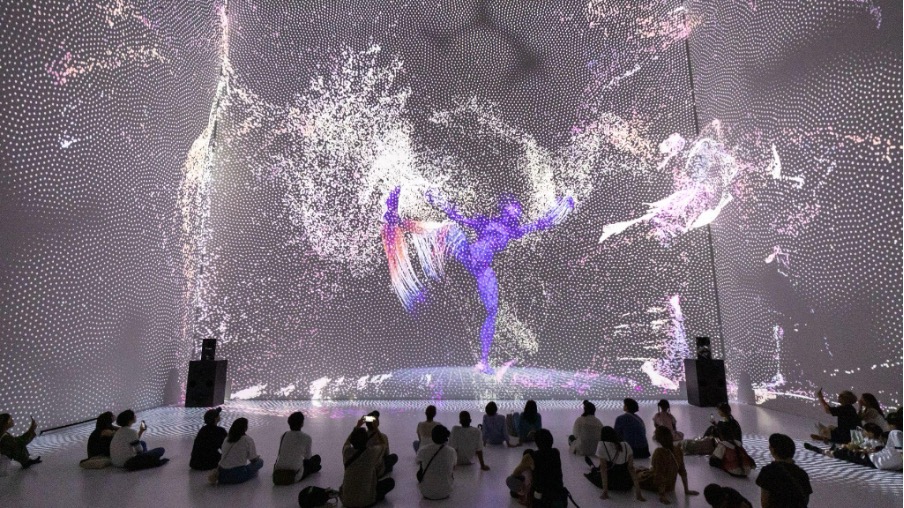
Introduction: The Birth of "Continuum Resonance"
Manabe began making artworks in the early 2000s and has presented a great number of creations, including performance works and commercial works. Behind this, he has been systematically organizing all of his works at a meta-level as a neuron-like network matrix from the perspective of thought orientation and technical classification. For the opening exhibition of VS., we initially planned to comprehensively show a selection from Manabe's vast array of work approaches, including works that analyzed brain neural information, the latest works including generative AI, and selected archive videos. However, when we saw the spatial characteristics of the VS. facility design supervised by Tadao Ando, we changed our thinking to focus on what content would be most appropriate to take advantage of the fact that each studio space, while not designed to be completely uniform in capacity or shape, is closely adjacent. We decided to reconsider from scratch what artworks would be appropriate for effective utilization.
This is where a new concept emerged. It was to expand multi-layered and acoustic ideas and create a continuous/discontinuous space for the entire VS. In media art installations, audio/visual expressions are often used, but there are not many high-level artists who approach and consciously create acoustic spatial creations, not just audio or musical processing. Manabe is counted as one of the few talented individuals in the world who can pioneer and create space from sound/acoustics. In other words, "Continuum Resonance" is an attempt to relate the different spaces inherent in VS. through acoustic chains and differences.
Development and Applicability of "PolyNodes"
Fortunately, Manabe had just released "PolyNodes," a software for 3D audio creation, co-developed with Turkish programmer Sinan Bökesoy. There was a great possibility of fully demonstrating this software and applying it extensively in a work for the first time. Moreover, these two had in common that they were greatly artistically and spiritually influenced by Iannis Xenakis, a giant of 20th-century contemporary music composition. Xenakis is a legend in the contemporary music world, but he can also be seen as playing an important role as an originator of media art. As the curatorial advisor for this project, I was familiar with all areas of Xenakis's activities, but when Manabe first showed me a demo of "PolyNodes," I couldn't help but be surprised that Xenakis's concepts and achievements from quite some time ago had come to fruition in a greatly advanced form as digital software after about half a century. Privately, at this stage, I was convinced that Manabe should fully develop a series using "PolyNodes." This was actually realized as a media art installation in the VS. studio space that exceeded imagination.
Iannis Xenakis's Foresight
So let me briefly explain why the influence of Xenakis from about half a century ago is important here. Xenakis, who studied architecture under Le Corbusier and became a renowned contemporary composer studying under Olivier Messiaen, is known for his stochastic music technique that applied probability statistical distributions to composition. At the same time, he was dedicated to creating three-dimensional sound organizations in space, aiming to form particle-like sound clouds modeled after physical Brownian motion. While most composers focused on the formation of autonomous structures in music, Xenakis took a unique stance in that he was concerned with the density of sound in three-dimensional space itself. In "Pithoprakta" (1955-56), mainly using glissandos of string instruments and trombones, sound clouds appear to be formed on a theoretical three-dimensional graphic score, but in actual performance, the sound/acoustics by performers arranged on a floor plane are just dispersed two-dimensionally, carrying the contradiction that they do not actually become cloud-like 3D acoustics in three-dimensional space (he himself was involved in developing software called "UPIC" for score formation using early computer programs). To solve this problem, Xenakis went on to develop and create 3D space installations "Polytopes" (1967-1978) and "Diatope" (1978) using lighting, laser beams, reflective mirrors, and sound (these can be said to have a dense and grand concept that can be considered pioneering media art installations). In other words, Xenakis's focus was not on the exterior design of architectural structures, but rather on the nature of the internal spatial organization itself. This origin can already be recognized in the construction of the "Philips Pavilion" at the 1958 Brussels World's Fair. At that time, he attempted to create a 3D acoustic space by dispersing 425 speakers on the interior walls with a hyperbolic paraboloid structure.
However, "Polytopes" was ahead of its time, and technology had not caught up to the desired level of conception. And after Xenakis, no one appeared to inherit it, and it was forgotten. Almost contemporaneously, sociologist Henri Lefebvre advocated for the conceptual deconstruction/reconstruction of cities, approaching it from the dual concepts of "explosion" and "implosion" in "The Production of Space" (1974), and Xenakis's thinking about architectural space as a generative process can be said to be in sync with this. Chronologically, various algorithmic architectures by computation were discussed thereafter, but most of them ended up with exterior structural design, and there are almost no examples that mention the generative organization of interior space. And about half a century later, the unique programming talents of Manabe and Bökesoy updated this fundamental internal space issue of Xenakis into an unexpectedly innovative idea through digital software.
Relationship between "PolyNodes" and "Continuum Resonance"
This "PolyNodes" divides the waveform of sound represented in two dimensions into three layers of "macro/meso/micro" (which Xenakis also used in settings) and assigns them to points in virtual space to create three-dimensional relationships. Furthermore, it is a program that self-organizes space itself while transforming as 3D acoustics, self-generating pitch, intensity, and time through parameters. In this "Continuum Resonance," individual works are installed in four studio spaces, but "PolyNodes" is used as a common element underlying all four, and since its solutions are different for each, it can be seen as a kind of developmental system. In other words, here in "Continuum Resonance," the "explosion" is the audiovisual media reproduction device (hardware), and the "implosion" is the program entity "PolyNodes" (software). As Marshall McLuhan pointed out, media art has the function of leaping thought from the present to the distant past, re-extracting and re-evaluating its essential issues by sampling, but Manabe has newly revived and leaped forward the unfinished spatial orientation attempted in Xenakis's "Polytopes" as a (universally accessible) plugin software, and moreover, these are actually generated into various forms by algorithms. Furthermore, in "Continuum Resonance," the position and movement information of viewers present in the venue will also be reflected in the code information in some form.
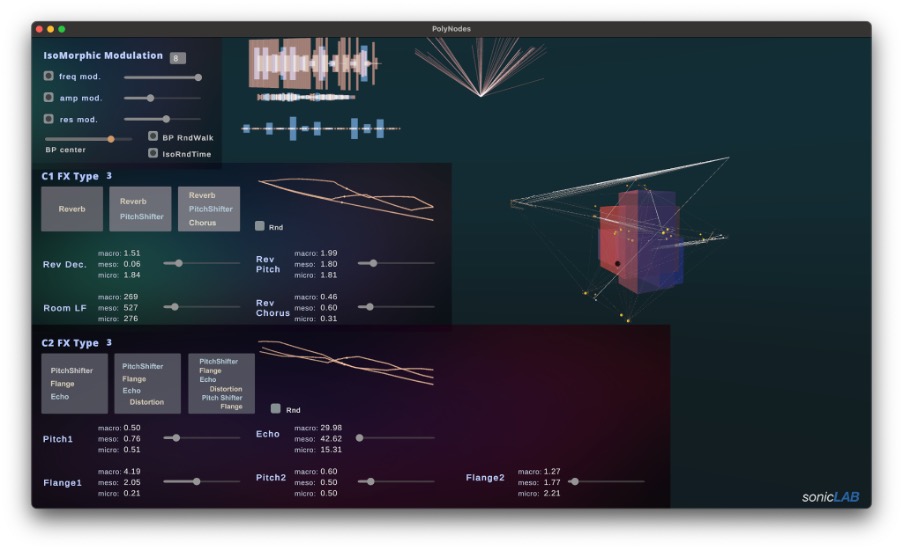
Each Studio Spaces and Artwork Characteristics
"PolyNodes Installation Debug Views" (Work1) displays the basic spatial functions of "PolyNodes," which can be enjoyed as a tight audiovisual expression [Sound: 5.1ch] in itself. Here, not only the position but also the gesture (a kind of shadow puppet of the body) information of the audience is captured. The audience's position information is set to be reflected in the spatial organization and cluster changes on "PolyNodes," with each assigned sound being interrelated, which of course affects the real-time generation changes and sound effects of the audio. Also, the internal spatial information of the architecture is acquired by sensor scanning as 3D spatial information and reflected in "PolyNodes." This basic principle is similarly applied to "PolyNodes Visualization" (Work 2) and "PolyNodes Augmentation" (Work 3).
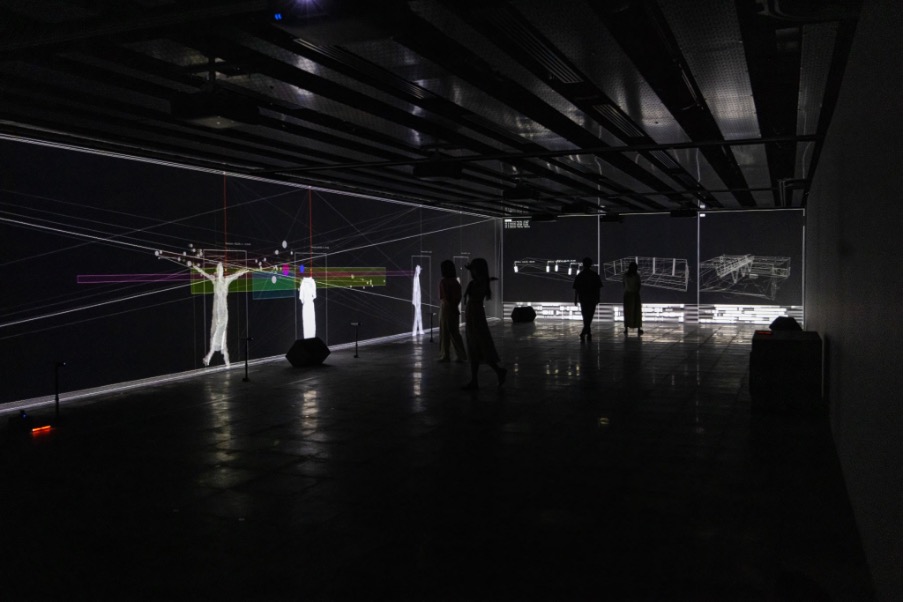
"PolyNodes Visualization" (Work 2) is a greatly developed form of the anteroom, with video projection only on the front single channel, but 3D spatial mapping and object expressions are greatly added, and above all, the generative function of "PolyNodes" is greatly activated to the point of being maxed out. Synthesizers and electronic sounds are added to the sound, and although it's 5.1ch sound, a considerable blast of 3D acoustics is formed. The sound files are meticulously composed by Manabe in advance, but it's a dense music that mixes complex off-beats, industrial, and hip-hop reminiscent of experimental music, and moreover, the fact that danceable elements are lurking in the deep layer can be said to be Manabe's true worth. Some might wonder how this connects sonically with Xenakis, but "PolyNodes" is a 3D acoustic generation software that basically works regardless of what music sound file is assigned. In other words, it's not the quality of the music but the aspect of space that's important. Xenakis himself actually installed Edgar Varèse's musique concrète work "Poème Électronique" on the 3D sound reproduction device at the "Philips Pavilion" at the 1958 Brussels World's Fair, so the situation can be seen as the same. Furthermore, as a developmental element in "PolyNodes," it's possible to perceive the distortion of non-linear space by moving black holes solely through acoustic spatial expression.
In "PolyNodes Visualization" (Work 2) , the visual expression depicts the "PolyNodes" organization more three-dimensionally, forming space as a pseudo-visual depth, with multiple light sources set within the "PolyNodes" generation organization, in a complex composition where light sources are turned on/off in sync with rhythm explosions. The images of shadows generated by the changes in the "PolyNodes" organization generated on the surrounding walls are momentarily projected depending on the position of the light sources.
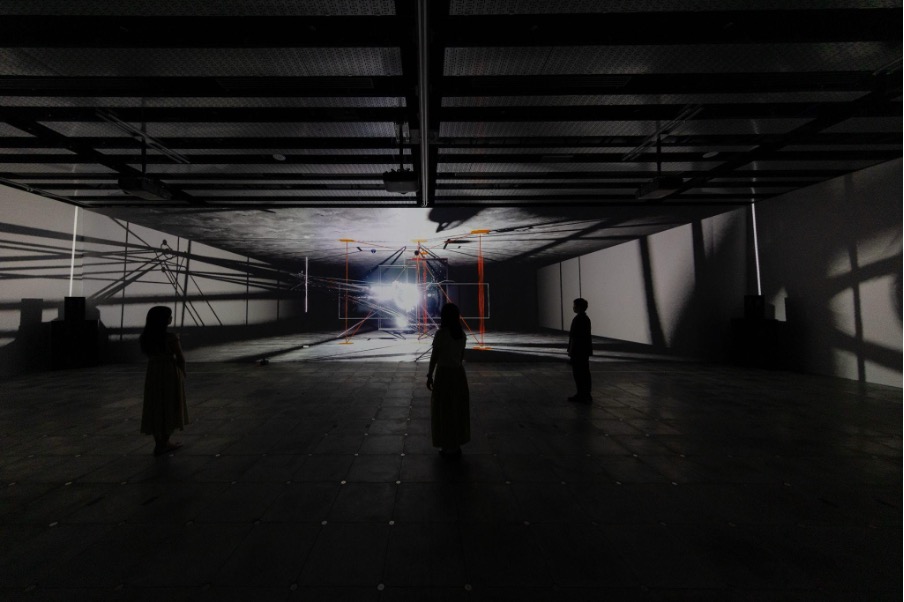
"Shadow Stage"
Art historian Victor I. Stoichita deals with the concept of the "shadow stage" in "A Short History of the Shadow" (1997). This is a proposal for an outlook on art history that suggests that the act of tracing and imitating forms through shadows might precede Jacques Lacan's "mirror stage," but Manabe has been pointing out from his recent activities that a shift is occurring from the age of "imitation/reproduction" to "generation," and that the meaning and existence of space may be transformed by the embodiment of "generation" that is currently emerging, overcoming the aesthetic dependence on "imitation" and "reproduction" that has dominated Western art for thousands of years. In other words, he's reading into the essential turn that Xenakis's proposal might be the bud of this.
In the commissioned work "Hiroshima-Thank-You-Instrument" (1995) at Hiroshima City Museum of Contemporary Art, Ingo Günther covered the entire wall surface of the dark room venue with phosphorescent paint, and by flashing a strobe momentarily, the shadows of the viewers in the venue space were burned onto the wall, physically remaining as afterimages for several minutes. Here, the implosion of atomic fission is suggested to record only the originally immaterial shadow image beyond the materiality of the body in an explosive manner, but if we consider this as a problem of representation, we might be able to extract a critique from the comparison of both, such as how to accept the new situation where the existence of the immaterial software "PolyNodes" creates immaterial shadow images.
AR System and Tactile Experience of Shadow Images
In "PolyNodes Augmentation" (Work 3), the space is further expanded, and coupled with the asymmetrical architectural form, here synchronized video projections are made on all-round full wall surfaces. The basic specifications and structure of "PolyNodes" are almost the same as "PolyNodes Visualization" (Work 2). The difference is that an AR system has been introduced here, and the immaterially generated cluster forms and generative changes can only be visually confirmed on the installed monitors. The wall images are only shadowy images of clusters with fantastical and eerie filters applied, with a stronger emphasis on afterimages. The audience's position information is more actively involved in cluster generation in "PolyNodes Augmentation" (Work 3) than in other works. The wall surface is less a faithful reflection of visual information and more a strong perception of tactile extended senses. In some cases, viewing with VR/AR HMDs might also be possible. The sound is 4.4ch, with further enhanced low frequencies developing into a massive ambient sound. It could be called a space of vibration. The PA system this time introduces BWV equipment newly developed by Eastern Sound Factory, which was created after sharing the sound creation image with Manabe in advance. "Continuum Resonance" is realized through VS.'s continuous space and the preparation of such an audiovisual environment, and it can be said that the interaction between the grand creation concept and the production environment is the result of such wonderful situational conditions being established.
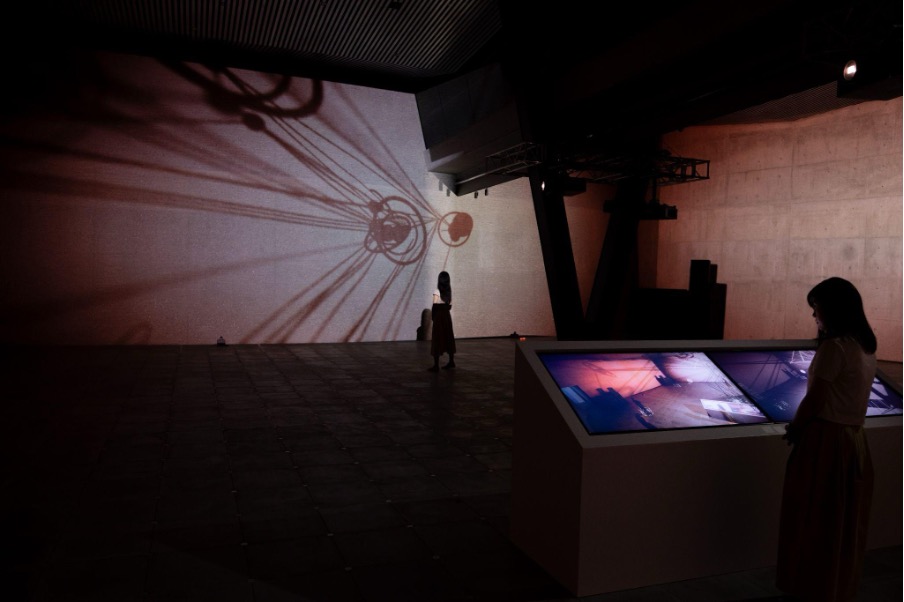
Physicality: Reference to Oskar Schlemmer
In "Synthesis of Body-Space-Music"(Work 4), the studio space is now greatly expanded upwards, and the audience is thrown into a huge vertical space with a ceiling height of 15m. In this space, for the first time, body module images appear in the video. Instead of installing position sensing for the audience, the "PolyNodes" parameters are influenced by the body data of dancers who were motion-captured as models, generating sound. Unlike the other three works, this is a screening format where pre-produced video files and sound files are output and played back in a loop as completed data. Thematically, human body images that have become huge abstract module expressions appear in the video as one to multiple bodies, referencing the correlation between Oskar Schlemmer's "artificial figures" from the Bauhaus and space, unfolding before our eyes as a gorgeous immersive solution in modern style. The sound is set with powerful 5.1.4ch, with 12 speakers installed especially in the studio ceiling part, so there's a sense of oppressive 3D sound and vibration from above, passing through the body as if scanning it multiple times. What should we call this bodily sensation?
Physicality: Reference to Oskar Schlemmer
Looking through these four "Continuum Resonance" works, we can see that the spatial generation by "PolyNodes" is always acting in a chain-like manner, but at the same time, it becomes clear that human physicality is related as a base, becoming shadows and highlights. Furthermore, "Continuum Resonance" makes us reconsider the relationship between dispersed physicality by "macro/meso/micro" modes, the "explosion" of drawing and the "implosion" of bodily sensation, along with the experience of spatial generation. Didn't Schlemmer not only describe the relationship between the objective body on stage and the environmental world, but also refer to the relationship between the physiological fluidity of the body lacking subjectivity in a sense and space? "Continuum Resonance" resonates with the critical state of thought and sensation by revealing detailed and complex multifaceted approaches.
*For detailed information on programming and operation related to "PolyNodes," refer to the "SPECIAL REPORT" on pages 036-041 of the December 2024 issue of "Sound & Recording" magazine (Rittor Music, Inc.)
* Photo by Muryo Homma (Rhizomatiks)
Text/Kazunao Abe (Curatorial Advisor/Tokyo Polytechnic University)
Abe Kazunao
Art curator, producer, professor at Tokyo Polytechnic University Faculty of Arts
Born in 1960. Graduated from Tokyo National University of Fine Arts and Music, Department of Aesthetics.
1990-2001 Canon Inc. “Art Labo”: Full-time project curator.
2003-2017 Yamaguchi Center for Arts and Media (YCAM): artistic director and deputy director.
2019- Professor, Faculty of Arts, Tokyo Polytechnic University.
Jury history:
2006 “transmediale award 06” Berlin, International Jury
2014-16 “Agency for Cultural Affairs Art Encouragement Prize”, Selection Jury, Media Arts Category
Jury member of the Art Division of “Japan Media Arts Festival”, 2017-2019
2017-2019 Juror, Arts Council Tokyo (Tokyo Metropolitan Government/Tokyo Metropolitan Foundation for History and Culture) Tokyo Culture Program Grant
2022- Member of “Study Group on Art and Economic Society”, Ministry of Economy, Trade and Industry
Curatorial:
2018 Guest curatorial director of the 3rd ACT Festival, National Asian Cultural Center, Korea “Otherly Space/Knowledge” exhibition curation (Kangju, Korea)
2019 evala+Akio Suzuki, “Hearing Elephant Happening Scenery” Exhibition (Nakatsu Manzoen, Marugame, Japan)
2023 Takashi Ikegami + Tatehide Niitsuubo + evala “Mind Time Machine II” (Research Center for Advanced Science and Technology, University of Tokyo)

